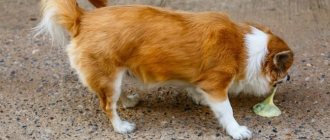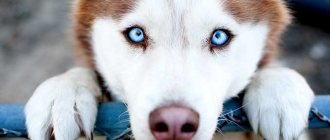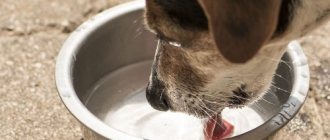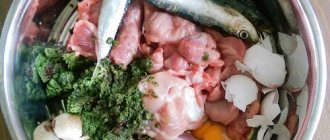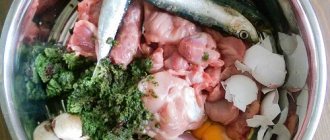February 2, 2020
Many owners have had to deal with the problem of their dog vomiting dry food immediately after eating or several hours later. This causes serious concern for the health of the pet and uncertainty about the correctness of the diet used.
Of course, vomiting is a rather alarming sign. And if it occurs repeatedly, it is better to consult a veterinarian. But sometimes even a completely healthy animal can vomit food.
Main causes of food vomiting
When vomit is detected after eating food, the thought immediately appears that the animal has been poisoned. However, in most cases, this sign does not pose a threat to the pet's health.
If gastric emptying occurs for the first time and once, then there is nothing to worry about.
The main causes of vomiting with food:
- Food intolerance. The digestive tract is sometimes too sensitive to certain components of the feed. More often, vomiting occurs when consuming Economy class products or natural food from the list of prohibited foods. Characteristic symptoms: the appearance of rashes, redness on the skin, sneezing, tearing, and sometimes discharge from the nasal cavity.
- Poor quality food. Economy class products usually cause vomiting. Low quality can be easily identified by a strong, unpleasant odor. But sometimes the situation is the opposite - a complete lack of aroma is also a sign of poor quality dry granules.
- Pregnancy or breastfeeding. Toxicosis is an unpleasant problem not only for people. Dogs also suffer from nausea and vomiting during pregnancy due to hormonal fluctuations.
- Physical activity after eating food. If the dog is playful, then after the next meal it will begin to move a lot, jump, and run. This will cause the feed mass to shake in the stomach, which will slow down the digestion process.
- Motion sickness. Dogs, like people, can have trouble with travel. Vomiting is associated with destabilization of the vestibular apparatus, which begins to get confused in signals, causing disturbances in the functioning of the nervous system.
- Haste. It happens that the dog begins to swallow food quickly and in large pieces. The stomach does not have time to prepare to process food. It affects areas not covered by gastric juice, causing irritation of the mucous walls.
- Binge eating. When eating a large amount of food, a food lump rises to the throat, causing vomiting.
- Eating greens and grass in large quantities. Fiber from plants is poorly digested, but at the same time it releases substances that irritate the intestinal walls.
- Heatstroke, sunstroke. Overheating causes increased blood pressure and dilation of blood vessels, which reduces blood supply to organs. This slows down the digestion process.
The listed reasons are easy to identify and eliminate. It is enough to monitor the quality, freshness of food, portion sizes, and limit physical activity after meals. It is not a good idea to feed your pet before a trip or walk on a sunny day.
Interesting! Pet owners who keep male dogs often experience vomiting in their pets. Males lose their appetite when they see a female during mating season. Inexperienced owners try to trick the pet into giving it food, which leads to vomiting. The reason is that the body is configured to copulate with the female, and not to process food.
Preventing vomiting in dogs at home
Photo: pixabay.com
Knowing the reasons why a dog vomits, you can do everything to prevent this unpleasant phenomenon for both the dog and its owner. And here are some recommendations that may help you and your four-legged friend:
- do not overfeed your pet, no matter how unhappy and hungry his eyes look at his dining owners (and pets are masters at giving such expressions to their faces);
- do not feed your dog fatty foods, especially pork, which is generally contraindicated for them;
- if your dog is allergic, try to exclude any contact of the animal with the allergen;
- do not keep the dog in the scorching sun for a long time and do not lock it in the car in the summer;
- in early childhood, teach your puppy not to put anything in his mouth on the street;
- do not give your dog toys with small parts or those that are easy to tear or chew;
- regularly carry out helminthiasis prevention;
- Try to keep your dog out of stressful situations.
If your dog eats very greedily, purchase a special bowl that will prevent him from swallowing large portions of food.
The dog vomited after eating: the differences between vomiting and regurgitation
The dog vomited after eating: the difference between vomiting and regurgitation is an important question, since these phenomena are often confused. Before identifying differences, it is worth deciding on the meaning of the concepts.
Vomiting is a protective mechanism that is activated when foreign irritants are ingested. It could be a foreign body, a toxic substance, or a pathogenic bacterium. The mechanism manifests itself as a sharp spasm of the stomach muscles, which leads to its emptying.
Regurgitation is a reflex process when food masses are thrown from the stomach into the oral cavity.
Causes:
- swallowing food along with air;
- inhalation;
- inhibition of food down the throat or in the esophagus;
- overeating, which causes the formation of gases that leave the stomach through the oral cavity.
Regurgitation is a natural process that does not cause discomfort to the animal. Sometimes it occurs directly during a meal, which does not interfere with further eating.
Differences between vomiting and regurgitation:
- When regurgitating, there is no bile. Vomiting is accompanied by the release of mucus, bile, and saliva.
- Vomiting is accompanied by a powerful, abundant flow of feed mass. When regurgitating, food comes out formed, undigested, sometimes with saliva.
- Regurgitation is a natural phenomenon that does not cause discomfort. Vomiting is a sign of illness. It is accompanied by pain, weakness, and nausea.
- Vomiting occurs at any time. Regurgitation occurs after eating, sometimes together with belching.
Knowing how to distinguish vomiting from regurgitation will help determine the degree of danger of the phenomenon occurring to your pet. If a bad condition is detected, it is better to show the animal to a veterinarian.
Vomiting up undigested food
On average, the time from food intake to entering the intestines in puppies is from 3 to 5 hours. This figure depends on the type of food.
- Dry food takes longer to digest; on average, the journey to the intestines takes five hours.
- For natural food it’s faster – about three hours.
The final digestion of food takes:
- With natural feeding, six hours.
- When feeding dry food, final digestion takes an average of eight hours.
Reference! You need to understand the difference between vomiting and regurgitation.
- Vomiting is accompanied by strong salivation and has many different causes. When vomiting, the animal most often changes in behavior, and anxiety is noticeable. During this process, the whole body is involved, the puppy may back away and hunch over.
- Regurgitation does not cause much discomfort for the dog. Most often in puppies this is due to overeating.
What to do and how to help a dog if it is vomiting
The first question that worries owners who are faced with vomiting in their pet is what to do and how to help their dog if it is vomiting.
The correct decision would be to adhere to the following recommendations:
- Do not try to stop the emptying of the stomach. Vomiting is a defense mechanism as the body tries to get rid of foreign substances.
- Try to identify the cause of the pet’s poor condition. This will help the doctor when prescribing treatment.
- Determine the appearance, consistency and composition of vomit. Sometimes they may contain blood or fragments of parasites.
- Give your pet low-fat meat broth if the vomiting has stopped. In the future, a diet of boiled foods without salt is required.
- Keep your dog away from water for the first few hours. If the animal is thirsty, then it is allowed to give an ice cube for licking.
- Gently palpate the abdomen. Manipulation will help identify a foreign body if this is the cause of vomiting.
If the emptying of the stomach occurs once, then you will not need to see a doctor. However, you will have to change your diet. Acceptable foods: lean meat (chicken or turkey), oatmeal, brown rice, greens.
Contact your veterinarian immediately
This list of causes of vomiting with dry food is far from exhaustive. It can be a sign of many chronic and infectious diseases that require medical intervention. We strongly recommend that you immediately contact a veterinary clinic if:
- the dog vomited repeatedly, not only from dry food, but also from any other food or water;
- the animal strives to find a secluded place, does not want to play or go for a walk;
- body temperature is elevated or significantly below normal (37.5–39°C).
Delay in such situations can cost the pet’s life, since dehydration with uncontrollable vomiting occurs very quickly, especially in puppies.
When there are no other symptoms, but the dog regularly vomits dry food, consulting a specialist will also not be superfluous. Perhaps your pet suffers from some chronic disease, identifying which at an early stage can significantly improve the prognosis and get rid of unpleasant symptoms.
Vomiting caused by diseases
Vomiting caused by diseases is sometimes the only indicator of a deteriorating pet’s condition. Features: multiple gastric emptyings; the presence of blood, worms, and other inclusions in the vomit.
Diseases that lead to vomiting:
- Worm infestation. Typically, helminths adhere tightly to the walls of the digestive tract. However, sometimes they come out with vomit. There are 2 reasons for this phenomenon: a large number of parasites or severe intoxication of the body.
- Gastrointestinal diseases - gastritis, ulcers on the walls of the stomach or intestines, trauma to the mucous membrane (for example, when large bones hit). A common symptom is the presence of blood in the vomit.
- Food allergies. The reaction develops when low-quality ingredients or components to which the stomach walls are sensitive are ingested. Common irritants: ash (inorganic elements), flavor enhancers, preservatives, flavors, synthetic fillers.
- Poisoning. Causes: stale food, drug overdose, insect bites, chemicals, poisonous gases. In addition to vomiting, diarrhea, weakness, trembling, breathing problems, abdominal pain, and other symptoms are often observed.
If vomiting is a sign of illness, then only a veterinarian can help your pet.
The owner needs to remember the appearance of the vomit, the number of gastric emptyings, and their duration. This will help the veterinarian make a diagnosis and prescribe treatment.
Age characteristics
Puppies are more susceptible to vomiting undigested food. This is due, as already listed above, to high mobility, improper eating habits, and worms, which cause more obvious symptoms in children than in adult dogs.
Also, at an early age, a dog may swallow a foreign object, such as a piece of a toy, which can lead to vomiting.
How to choose the right food for your dog
Improper feeding is the main cause of nausea and vomiting. Therefore, close attention should be paid to your pet’s nutrition. Owners need to know how to choose the right food for their dog.
Recommendations:
- the higher the class, the better the quality of the feed. Super-premium products are suitable for dogs, especially purebred ones. It contains high quality ingredients and natural additives;
- Read the ingredients before purchasing. For example, the best source of protein is lean meat or fish, not organ meats. The composition should not contain preservatives, flavor enhancers, or other artificial additives;
- select food in accordance with the physiological needs or health status of the animal. Popular manufacturers produce lines for puppies, adults, elderly, and pregnant dogs. There are hypoallergenic products, medicinal and dietary foods.
Properly selected food will help avoid problems with allergies or intolerances. Providing balanced and nutritious feeding is one of the main tasks for the owner.
Impurities in vomit
Vomit should be examined for the presence of mucus, foam, bile or blood.
Blood
If blood clots are detected, you should immediately contact a veterinarian . Its presence in vomit indicates serious illness and internal hemorrhage.
Yellow liquid
This is the secretion of bile. The cause may be poor nutrition or overeating. But this phenomenon can also indicate serious diseases . You shouldn’t put off going to a specialist either.
Green
Vomiting undigested food in which you notice green liquid most likely indicates a serious illness . This may be duodenal obstruction, infection, or the presence of worms.
Fertilizers and vitamin supplements
When treating the consequences of vomiting and poisoning, any nutritional supplements are prescribed by a veterinarian. The course of taking vitamins is interrupted for the rehabilitation period.
List of absorbents, drugs for restoring intestinal microflora:
- Lactobifadol. The drug contains lacto- and bifidobacteria and is used to treat dysbacteriosis, diseases of the gastrointestinal tract, kidneys, liver, and pancreas. Available in powder form. The product is added to lukewarm liquid food or boiled, cooled water.
- Lactoferon. Contains bifidobacteria, latcobacteria, used to destroy pathogenic intestinal flora and to increase local immunity. Available in tablet form. Give the drug to your pet along with water.
- Bifitrilak. A complex of prebiotics, natural sugars, antioxidants, used to restore intestinal microflora. The drug has an absorbent effect. Available in powder form. Give to your pet mixed with food or dissolved in boiled, cooled water.
- Tsamaks. Absorbent, used to eliminate vomiting, treat poisoning, dysbacteriosis. Available in the form of granules, tablets, and powder. Give to the animal with food.
- Enterosgel. Used to cleanse the dog's body of toxins. The drug is prescribed for the treatment of vomiting, diarrhea, and poisoning. Available in gel form.
Increased attention is paid to the pet's nutrition after vomiting. The diet consists of dietary, natural products. Conventional or medicinal food is administered a week or two after poisoning or an attack of gastrointestinal diseases. If pathologies of the intestines, pancreas or stomach are detected, the animal is transferred to special feed. They are chosen from the super premium or holistic categories.
What to do if nausea does not stop for a long time?
If the food has already come out, but the vomiting still does not stop and there is still diarrhea, go to a specialist as soon as possible. The combination of these factors leads to dehydration. This is especially dangerous for puppies from one month of age.
Attention! Dehydration in puppies can be fatal in just 24 hours.
To somehow alleviate the baby’s condition before visiting the veterinarian, do not feed him in the first place. If the puppy also vomits after drinking, eliminate the water; instead, you can give an ice cube or chamomile tea. The pet should be given activated charcoal.


